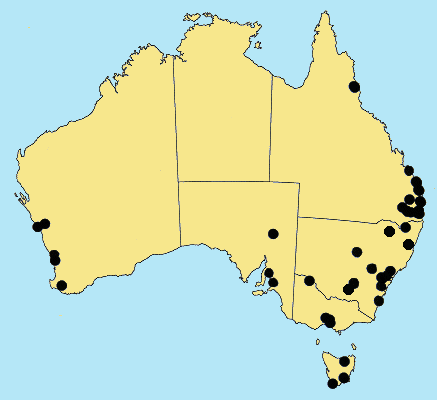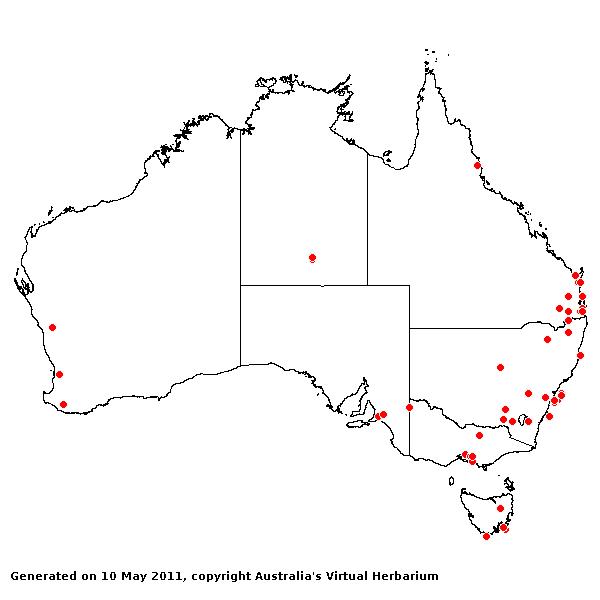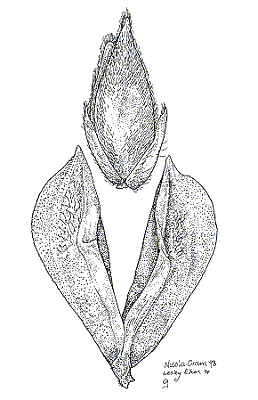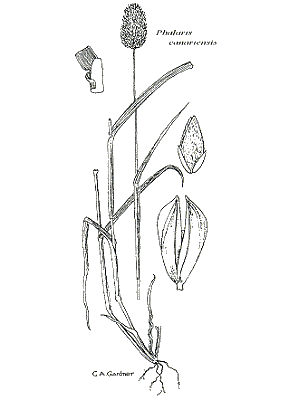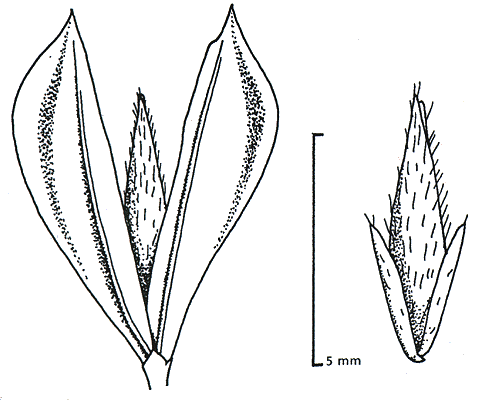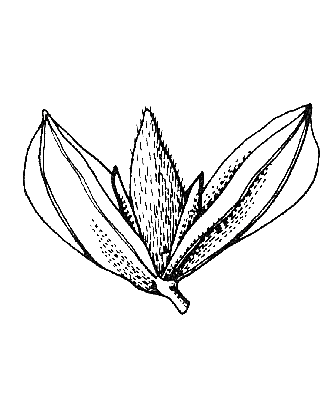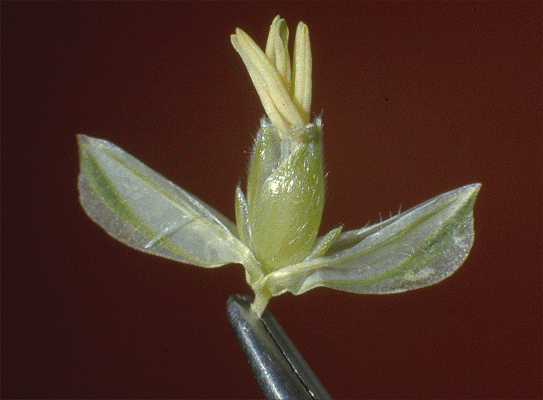Phalaris canariensis* L. Sp. Pl. 1:
54 (1753).
Classification. (GPWG 2001) : Subfamily Pooideae.
Tribe Poeae.
Type of Basionym or
Protologue Information: LT: Herb. Clifford 23, Phalaris n. 1, cult.,
(BM). CT proposed by Baldini & Jarvis, Taxon 40: 483 (1991); LT by
Anderson, Iowa St. J. Sci. 36: 59 (1961), inval..
Key references
(books and floras): [1878] G.Bentham, Flora Australiensis 7 (557),
[1952] C.A.Gardner, Flora of Western Australia 1 Gramineae (23),
[2002] D.Sharp & B.K.Simon, AusGrass, Grasses of Australia, [2002]
J.Wheeler, N.Marchant & M.Lewington, Flora of the South West (428), [2006]
J.Jessop, G.R.M.Dashorst, F.M.James, Grasses of South Australia (242),
[2008] S.W.L.Jacobs, R.D.B.Walley & D.J.B.Wheeler, Grasses of New South
Wales (338), [2009] A.Wilson (ed.). Flora of Australia, Vol 44A. Poaceae
2 (150).
Illustrations:
[1952] C.A.Gardner, Flora of Western Australia 1 Gramineae (24,
25 & 27, Pl. 4,5 & 6), [2006] J.Jessop, G.R.M.Dashorst, F.M.James, Grasses
of South Australia (242, fig. 185),
[2008] S.W.L.Jacobs, R.D.B.Whalley & D.J.B.Wheeler, Grasses of New South
Wales, 4th edn (338), [2009]. A.Wilson (ed.), Flora of Australia 44A:
Poaceae 2 (148, Fig.22).
Habit. Annual.
Culms erect or geniculately ascending, 20–120 cm tall, 5–6 -noded. Leaves
cauline. Ligule an eciliate membrane, 3–8 mm long, entire. Leaf-blades 5–31.5
cm long, 4–16 mm wide.
Inflorescence.
Inflorescence solid, a panicle. Panicle oblong or ovate, 1.5–6.3 cm long,
1.2–2.2 cm wide.
Spikelets.
Spikelets sessile. Fertile spikelets 1 or more flowered, with 1 fertile floret,
comprising 2 basal sterile florets, comprising 1 fertile floret(s), without
rachilla extension, obovate, laterally compressed, 6–10 mm long.
Glumes.
Glumes similar, thinner than fertile lemma. Lower glume elliptic, chartaceous,
keeled, 1-keeled, winged on keel, winged broadly, 3–5 -nerved. Lower glume
surface glabrous or indumented. Lower glume apex muticous. Upper glume
elliptic, 6–10 mm long, chartaceous, keeled, 1-keeled, winged on keel, 3–5
-nerved. Upper glume surface asperulous, indumented. Florets. Basal
sterile florets 2 or more, barren, without significant palea. Lemma of lower
sterile floret 40–60 % of length of spikelet, membranous, without keels or
1-keeled. Lemma of upper sterile floret 2.5–3.4 mm long.
Fertile lemma 4.6–6 mm
long, keeled, 5 -nerved. Lemma surface indumented. Palea 2 -nerved, without
keels. Lodicules present. Anthers 3.
Continental
Distribution: Europe, Africa, Temperate Asia, Tropical Asia, Australasia,
Pacific, North America, and South America.
Australian
Distribution: Western Australia, South Australia, Queensland, New South
Wales, Victoria, Tasmania, Lord Howe.
Western Australia:
Drummond. South Australia: Flinders Ranges, Northern Lofty, Southern
Lofty. Queensland: Cook, Darling Downs, Moreton, Wide Bay. New South
Wales: Central Coast, South Coast, Central Tablelands, Central-Western
Slopes, South-Western Slopes, North-Western Plains. Victoria: Gippsland
Plain, Midlands, Murray Mallee, Volcanic Plain. Tasmania: Midlands, East
Coast.
Notes.
Cultivated for bird seed, also palatable to stock.
A species readily distinguished by its
relatively large foliaceous sterile florets.
Introduced.
All states and territories except the N.T., also on Lord Howe Is. Native to N
Africa and the Canary Is., now introduced and naturalized in many countries. In
dry habitats, on disturbed soils, often with a preference for sandy soils,
often arising from the discarded cleanings from bird cages. Flowers Sept.-Mar. Fruits Sept.-Dec.
